Yukun Huang
HoloPart: Generative 3D Part Amodal Segmentation
Apr 10, 2025Abstract:3D part amodal segmentation--decomposing a 3D shape into complete, semantically meaningful parts, even when occluded--is a challenging but crucial task for 3D content creation and understanding. Existing 3D part segmentation methods only identify visible surface patches, limiting their utility. Inspired by 2D amodal segmentation, we introduce this novel task to the 3D domain and propose a practical, two-stage approach, addressing the key challenges of inferring occluded 3D geometry, maintaining global shape consistency, and handling diverse shapes with limited training data. First, we leverage existing 3D part segmentation to obtain initial, incomplete part segments. Second, we introduce HoloPart, a novel diffusion-based model, to complete these segments into full 3D parts. HoloPart utilizes a specialized architecture with local attention to capture fine-grained part geometry and global shape context attention to ensure overall shape consistency. We introduce new benchmarks based on the ABO and PartObjaverse-Tiny datasets and demonstrate that HoloPart significantly outperforms state-of-the-art shape completion methods. By incorporating HoloPart with existing segmentation techniques, we achieve promising results on 3D part amodal segmentation, opening new avenues for applications in geometry editing, animation, and material assignment.
Fuzzy Speculative Decoding for a Tunable Accuracy-Runtime Tradeoff
Feb 28, 2025Abstract:Speculative Decoding (SD) enforces strict distributional equivalence to the target model, limiting potential speed ups as distributions of near-equivalence achieve comparable outcomes in many cases. Furthermore, enforcing distributional equivalence means that users are unable to trade deviations from the target model distribution for further inference speed gains. To address these limitations, we introduce Fuzzy Speculative Decoding (FSD) - a decoding algorithm that generalizes SD by accepting candidate tokens purely based on the divergences between the target and draft model distributions. By allowing for controlled divergence from the target model, FSD enables users to flexibly trade generation quality for inference speed. Across several benchmarks, our method is able to achieve significant runtime improvements of over 5 tokens per second faster than SD at only an approximate 2% absolute reduction in benchmark accuracy. In many cases, FSD is even able to match SD benchmark accuracy at over 2 tokens per second faster, demonstrating that distributional equivalence is not necessary to maintain target model performance.
GenMAC: Compositional Text-to-Video Generation with Multi-Agent Collaboration
Dec 05, 2024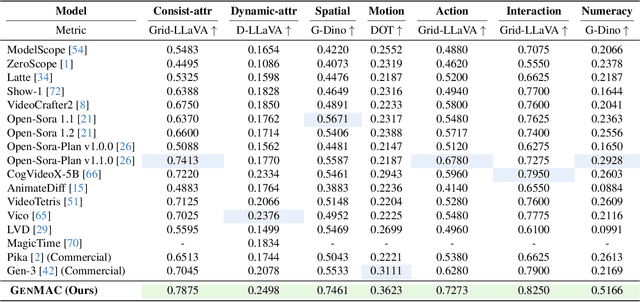

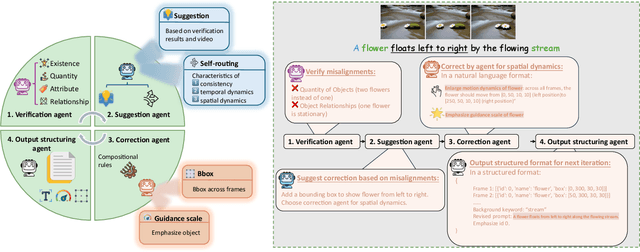
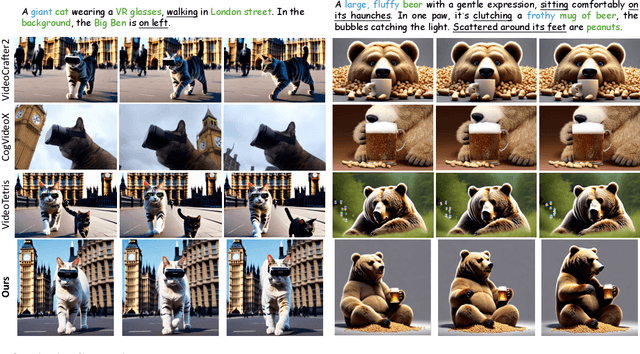
Abstract:Text-to-video generation models have shown significant progress in the recent years. However, they still struggle with generating complex dynamic scenes based on compositional text prompts, such as attribute binding for multiple objects, temporal dynamics associated with different objects, and interactions between objects. Our key motivation is that complex tasks can be decomposed into simpler ones, each handled by a role-specialized MLLM agent. Multiple agents can collaborate together to achieve collective intelligence for complex goals. We propose GenMAC, an iterative, multi-agent framework that enables compositional text-to-video generation. The collaborative workflow includes three stages: Design, Generation, and Redesign, with an iterative loop between the Generation and Redesign stages to progressively verify and refine the generated videos. The Redesign stage is the most challenging stage that aims to verify the generated videos, suggest corrections, and redesign the text prompts, frame-wise layouts, and guidance scales for the next iteration of generation. To avoid hallucination of a single MLLM agent, we decompose this stage to four sequentially-executed MLLM-based agents: verification agent, suggestion agent, correction agent, and output structuring agent. Furthermore, to tackle diverse scenarios of compositional text-to-video generation, we design a self-routing mechanism to adaptively select the proper correction agent from a collection of correction agents each specialized for one scenario. Extensive experiments demonstrate the effectiveness of GenMAC, achieving state-of-the art performance in compositional text-to-video generation.
The Matrix: Infinite-Horizon World Generation with Real-Time Moving Control
Dec 04, 2024



Abstract:We present The Matrix, the first foundational realistic world simulator capable of generating continuous 720p high-fidelity real-scene video streams with real-time, responsive control in both first- and third-person perspectives, enabling immersive exploration of richly dynamic environments. Trained on limited supervised data from AAA games like Forza Horizon 5 and Cyberpunk 2077, complemented by large-scale unsupervised footage from real-world settings like Tokyo streets, The Matrix allows users to traverse diverse terrains -- deserts, grasslands, water bodies, and urban landscapes -- in continuous, uncut hour-long sequences. Operating at 16 FPS, the system supports real-time interactivity and demonstrates zero-shot generalization, translating virtual game environments to real-world contexts where collecting continuous movement data is often infeasible. For example, The Matrix can simulate a BMW X3 driving through an office setting--an environment present in neither gaming data nor real-world sources. This approach showcases the potential of AAA game data to advance robust world models, bridging the gap between simulations and real-world applications in scenarios with limited data.
SAMPart3D: Segment Any Part in 3D Objects
Nov 11, 2024Abstract:3D part segmentation is a crucial and challenging task in 3D perception, playing a vital role in applications such as robotics, 3D generation, and 3D editing. Recent methods harness the powerful Vision Language Models (VLMs) for 2D-to-3D knowledge distillation, achieving zero-shot 3D part segmentation. However, these methods are limited by their reliance on text prompts, which restricts the scalability to large-scale unlabeled datasets and the flexibility in handling part ambiguities. In this work, we introduce SAMPart3D, a scalable zero-shot 3D part segmentation framework that segments any 3D object into semantic parts at multiple granularities, without requiring predefined part label sets as text prompts. For scalability, we use text-agnostic vision foundation models to distill a 3D feature extraction backbone, allowing scaling to large unlabeled 3D datasets to learn rich 3D priors. For flexibility, we distill scale-conditioned part-aware 3D features for 3D part segmentation at multiple granularities. Once the segmented parts are obtained from the scale-conditioned part-aware 3D features, we use VLMs to assign semantic labels to each part based on the multi-view renderings. Compared to previous methods, our SAMPart3D can scale to the recent large-scale 3D object dataset Objaverse and handle complex, non-ordinary objects. Additionally, we contribute a new 3D part segmentation benchmark to address the lack of diversity and complexity of objects and parts in existing benchmarks. Experiments show that our SAMPart3D significantly outperforms existing zero-shot 3D part segmentation methods, and can facilitate various applications such as part-level editing and interactive segmentation.
Real-time Fake News from Adversarial Feedback
Oct 18, 2024



Abstract:We show that existing evaluations for fake news detection based on conventional sources, such as claims on fact-checking websites, result in an increasing accuracy over time for LLM-based detectors -- even after their knowledge cutoffs. This suggests that recent popular political claims, which form the majority of fake news on such sources, are easily classified using surface-level shallow patterns. Instead, we argue that a proper fake news detection dataset should test a model's ability to reason factually about the current world by retrieving and reading related evidence. To this end, we develop a novel pipeline that leverages natural language feedback from a RAG-based detector to iteratively modify real-time news into deceptive fake news that challenges LLMs. Our iterative rewrite decreases the binary classification AUC by an absolute 17.5 percent for a strong RAG GPT-4o detector. Our experiments reveal the important role of RAG in both detecting and generating fake news, as retrieval-free LLM detectors are vulnerable to unseen events and adversarial attacks, while feedback from RAG detection helps discover more deceitful patterns in fake news.
Enhancing Large Language Models' Situated Faithfulness to External Contexts
Oct 18, 2024Abstract:Large Language Models (LLMs) are often augmented with external information as contexts, but this external information can sometimes be inaccurate or even intentionally misleading. We argue that robust LLMs should demonstrate situated faithfulness, dynamically calibrating their trust in external information based on their confidence in the internal knowledge and the external context. To benchmark this capability, we evaluate LLMs across several QA datasets, including a newly created dataset called RedditQA featuring in-the-wild incorrect contexts sourced from Reddit posts. We show that when provided with both correct and incorrect contexts, both open-source and proprietary models tend to overly rely on external information, regardless of its factual accuracy. To enhance situated faithfulness, we propose two approaches: Self-Guided Confidence Reasoning (SCR) and Rule-Based Confidence Reasoning (RCR). SCR enables models to self-access the confidence of external information relative to their own internal knowledge to produce the most accurate answer. RCR, in contrast, extracts explicit confidence signals from the LLM and determines the final answer using predefined rules. Our results show that for LLMs with strong reasoning capabilities, such as GPT-4o and GPT-4o mini, SCR outperforms RCR, achieving improvements of up to 24.2% over a direct input augmentation baseline. Conversely, for a smaller model like Llama-3-8B, RCR outperforms SCR. Fine-tuning SCR with our proposed Confidence Reasoning Direct Preference Optimization (CR-DPO) method improves performance on both seen and unseen datasets, yielding an average improvement of 8.9% on Llama-3-8B. In addition to quantitative results, we offer insights into the relative strengths of SCR and RCR. Our findings highlight promising avenues for improving situated faithfulness in LLMs. The data and code are released.
DreamWaltz-G: Expressive 3D Gaussian Avatars from Skeleton-Guided 2D Diffusion
Sep 25, 2024



Abstract:Leveraging pretrained 2D diffusion models and score distillation sampling (SDS), recent methods have shown promising results for text-to-3D avatar generation. However, generating high-quality 3D avatars capable of expressive animation remains challenging. In this work, we present DreamWaltz-G, a novel learning framework for animatable 3D avatar generation from text. The core of this framework lies in Skeleton-guided Score Distillation and Hybrid 3D Gaussian Avatar representation. Specifically, the proposed skeleton-guided score distillation integrates skeleton controls from 3D human templates into 2D diffusion models, enhancing the consistency of SDS supervision in terms of view and human pose. This facilitates the generation of high-quality avatars, mitigating issues such as multiple faces, extra limbs, and blurring. The proposed hybrid 3D Gaussian avatar representation builds on the efficient 3D Gaussians, combining neural implicit fields and parameterized 3D meshes to enable real-time rendering, stable SDS optimization, and expressive animation. Extensive experiments demonstrate that DreamWaltz-G is highly effective in generating and animating 3D avatars, outperforming existing methods in both visual quality and animation expressiveness. Our framework further supports diverse applications, including human video reenactment and multi-subject scene composition.
Atomic Self-Consistency for Better Long Form Generations
May 21, 2024Abstract:Recent work has aimed to improve LLM generations by filtering out hallucinations, thereby improving the precision of the information in responses. Correctness of a long-form response, however, also depends on the recall of multiple pieces of information relevant to the question. In this paper, we introduce Atomic Self-Consistency (ASC), a technique for improving the recall of relevant information in an LLM response. ASC follows recent work, Universal Self-Consistency (USC) in using multiple stochastic samples from an LLM to improve the long-form response. Unlike USC which only focuses on selecting the best single generation, ASC picks authentic subparts from the samples and merges them into a superior composite answer. Through extensive experiments and ablations, we show that merging relevant subparts of multiple samples performs significantly better than picking a single sample. ASC demonstrates significant gains over USC on multiple factoids and open-ended QA datasets - ASQA, QAMPARI, QUEST, ELI5 with ChatGPT and Llama2. Our analysis also reveals untapped potential for enhancing long-form generations using approach of merging multiple samples.
Calibrating Long-form Generations from Large Language Models
Feb 09, 2024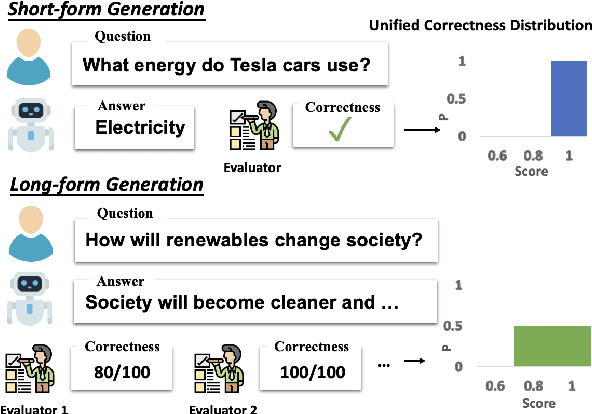
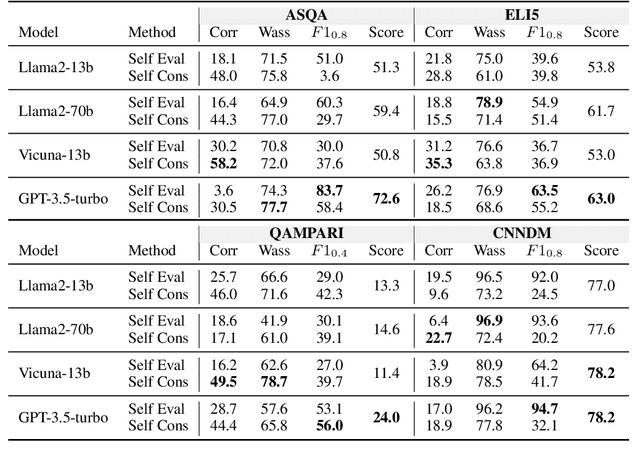

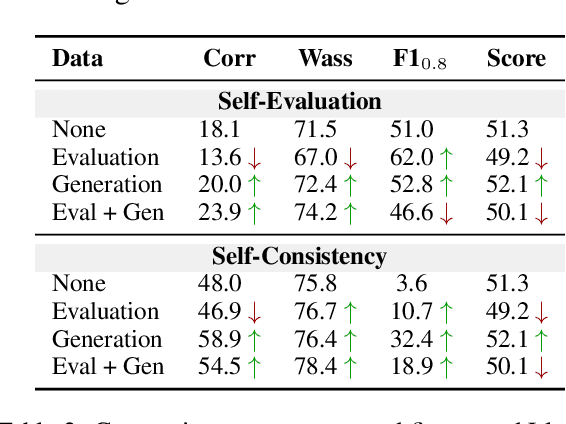
Abstract:To enhance Large Language Models' (LLMs) reliability, calibration is essential -- the model's assessed confidence scores should align with the actual likelihood of its responses being correct. However, current confidence elicitation methods and calibration metrics typically rely on a binary true/false assessment of response correctness. This approach does not apply to long-form generation, where an answer can be partially correct. Addressing this gap, we introduce a unified calibration framework, in which both the correctness of the LLMs' responses and their associated confidence levels are treated as distributions across a range of scores. Within this framework, we develop three metrics to precisely evaluate LLM calibration and further propose two confidence elicitation methods based on self-consistency and self-evaluation. Our experiments, which include long-form QA and summarization tasks, demonstrate that larger models don't necessarily guarantee better calibration, that calibration performance is found to be metric-dependent, and that self-consistency methods excel in factoid datasets. We also find that calibration can be enhanced through techniques such as fine-tuning, integrating relevant source documents, scaling the temperature, and combining self-consistency with self-evaluation. Lastly, we showcase a practical application of our system: selecting and cascading open-source models and ChatGPT to optimize correctness given a limited API budget. This research not only challenges existing notions of LLM calibration but also offers practical methodologies for improving trustworthiness in long-form generation.
 Add to Chrome
Add to Chrome Add to Firefox
Add to Firefox Add to Edge
Add to Edge